
The First Baptist Church in America is the First Baptist Church of Providence, Rhode Island, also known as the First Baptist Meetinghouse. It is the oldest Baptist church congregation in the United States, founded in 1638 by Roger Williams in Providence, Rhode Island. The present church building was erected between 1774 and 75 and held its first meetings in May 1775. It is located at 75 North Main Street in Providence's College Hill neighborhood. It was designated a National Historic Landmark in 1960. It is affiliated with the American Baptist Churches USA.
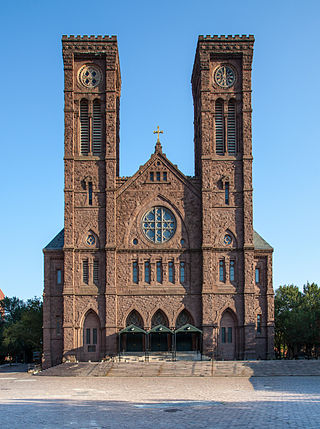
The Cathedral of Saints Peter and Paul is a Roman Catholic cathedral in the Cathedral Square neighborhood of Providence, Rhode Island, United States. It is the mother church of the Diocese of Providence. The Neo-Romanesque church was designed in 1873 by Patrick Keely and added to the National Register of Historic Places in 1975.
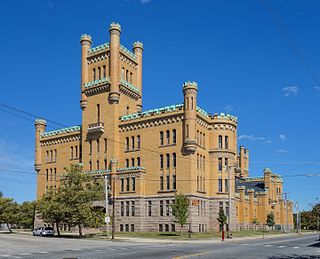
The West End is a neighborhood in the southwestern part of Providence, Rhode Island in the region often referred to as the South Side. Its boundaries are delineated by Westminster Street to the north, Huntington Avenue to the south, Elmwood Avenue to the east and the railroad tracks with Route 10 to the west. Cranston Street runs through the center of West End, past the Cranston Street Armory which has given the neighborhood the alternative name of the "Armory District."

Veterans Memorial Auditorium is a performing arts theater in Providence, Rhode Island. Construction began in 1928 but was delayed by the Great Depression. The theater was finally completed in 1950. The adjacent Performing Arts Complex was erected in 1970 and is partially owned by the Veterans' Memorial Foundation.

Allenville Mill Storehouse is a historic mill storehouse at 5 Esmond Street in Esmond, Rhode Island within the town of Smithfield, Rhode Island. The exact date of construction is unknown, but it was built with rubble masonry construction which was typical of mill construction during and after the War of 1812. In 1813, Phillip Allen purchased 4.5 acres of land and constructed a mill on the site, but the first record to specifically refer to the storehouse was an insurance policy from 1836. Allen sold the property in 1857 and it changed ownership several times before it became Esmond Mills in 1906. In 1937, the building was used as a post office and described erroneously as the "Old Allenville Mill". The building has had some alterations to the front door and possibly the addition of a side door, but the interior of the structure was not detailed in the National Register of Historic Places nomination. The Allenville Mill Storehouse was added to the National Register of Historic Places in 1972.
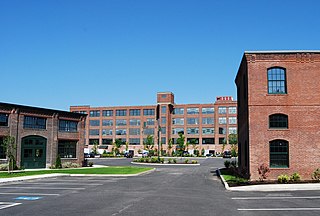
The Rumford Chemical Works and Mill House Historic District is a historic district encompassing the remnants of the Rumford Chemical Works, a historical chemical plant in East Providence, Rhode Island, founded by Eben Horsford and George F. Wilson.

Woonsocket Rubber Company Mill is an historic mill at 60-82 Main Street in Woonsocket, Rhode Island. The mill consists of a series of 3- and 4-story brick buildings built between 1865 and 1875 by Edward Harris, one of Woonsocket's leading businessmen. These buildings housed the Woonsocket Rubbert Company, one of Rhode Island's first manufacturer of rubber products, principally shoes, boots, and rubberized fabric. In 1910 the complex was purchased by the Falls Yarn Company, which used it for the production of fine woolen yarns.

The Governor William Sprague Mansion is an historic mansion and museum at 1351 Cranston Street in Cranston, Rhode Island. The house was the birthplace of Governor William Sprague III and his nephew, Governor William Sprague IV.

The Beaman and Smith Company Mill is an historic factory complex at 20 Gordon Avenue in Providence, Rhode Island. It consists of two masonry buildings at the junction of Gordon and Saratoga Streets in south Providence. The older of the two buildings is a one-to-two story brick structure, built in 1898 by the Berlin Iron Bridge Company. It has a steel frame, and is about 250 feet (76 m) long. The second building is an early example of concrete slab construction, built in 1917. It was designed by local industrial architecture firm, Jenks & Ballou. It is four stories in height, and is attached to the older building's south face. It originally had a brick surface, but much of this was stuccoed. The brick building presents four bays to Gordon Street, while the concrete one has two. The complex exemplifies two notable early modern construction methods, and is a symbol of the industrial development of south Providence in the late 19th century. Beaman and Smith was a manufacturer of precision machine tools; they went out of business in 1926. The complex was occupied for many years by the James Hill Manufacturing Company, who produced metal containers.

The Brown & Sharpe Manufacturing Company Complex is a historic factory complex in Providence, Rhode Island along the Woonasquatucket River. The 25-acre (10 ha) complex occupies most of a large city block bounded on the south by Promenade Street, the west by Bath and Calverly Streets, the north by West Park Street, and the east by Interstate 95. The complex was the longtime home of Brown & Sharpe Manufacturing Company, a manufacturer of precision equipment founded in 1833. The company was originally located in downtown Providence, but moved to this site in 1872, where it remained until 1964, when it moved to North Kingstown. Fourteen of the company's buildings survive.

The Covell Street School is an historic school building at 231 Amherst Street in Providence, Rhode Island. It is a two-story wood-frame structure built in a typically elaborate Queen Anne style. Although it is basically rectangular in plan, its roofline and exterior are busy, with a complicated group of cross gables, hip-roof sections, with projecting and recessed sections. A three-story square tower rises from the center of the main facade. Built in 1885 and opened in 1886, it is one of Providence's last surviving 19th-century neighborhood school buildings. It was designed by the local firm of William R. Walker & Son, designers of many Rhode Island civic buildings. The builders were John L. Sprague & Company.

The Davol Rubber Company is a historic industrial site at Davol Square, at Point and Eddy Streets in Providence, Rhode Island.
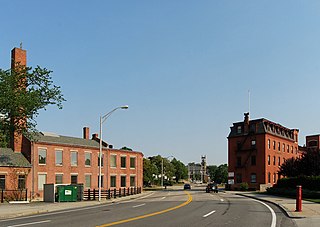
Moshassuck Square is an industrial historic district in Providence, Rhode Island, lining the banks of the Blackstone Canal just north of the Rhode Island State House. It consists of the few surviving buildings of the once-extensive American Screw Company complex, which was largely developed between the 1840s and 1870s, and was a major fixture in the Providence landscape prior to its destruction by fire in 1971. The buildings are in an area bounded by Charles Street on the west, Stevens and Hewes Streets on the north, North Main Street to the east, and Mill Street to the south. Prominent among them are the Stillman White Foundry and Fletcher Manufacturing Company office building, which stand on opposite sides of Mill Street near its crossing of the canal. At 127 Charles Street stands a three-story brick building built c. 1900 as a retail and residential building. The only surviving elements of the Screw Company complex are located at North Main and Hewes Streets, and now house the Providence Center.

The Perkins Buildings are a group of three historic industrial buildings located at 85 Sprague Street, 101 and 102 Westfield Street in Providence, Rhode Island. They were built between 1887 and 1892 by Charles H. Perkins, and were originally occupied by separate industrial tenants. Two of the buildings are brick structures built in 1892 and 1890, respectively, while the 1887 mill at 101 Westfield is a wood-frame structure, a rare 19th-century survivor in the state. These buildings were consolidated into a single industrial complex in the first half of the 20th century by the Rau Fastener Company, which operated on the premises until 1994.

The South Street Station is an historic electrical power generation station at 360 Eddy Street in Providence, Rhode Island. The structure has since been redeveloped and is now used as an administrative office and academic facility by a number of local universities.

The Hope Village Historic District is a historic rural mill settlement within Hope Village in Scituate, Rhode Island. Hope Village is located on a bend in the North Pawtuxet River in the southeastern corner of Scituate. Industrial activity has occurred in Hope Village since the mid-eighteenth century. Surviving industrial and residential buildings in the Historic District date back to the early 19th century. The village center sits at junction of Main Street and North Road. Hope Village radiates out from the center with houses on several smaller side streets in a compact configuration. Currently there is little commercial or industrial activity in Hope Village and none in the Historic District. The present stone mill building on the south side of Hope Village was built in 1844 by Brown & Ives of Providence, expanded in 1871 and modified in 1910. Approximately one quarter of the village's current housing stock was built as mill worker housing by various owners of Hope Mill.
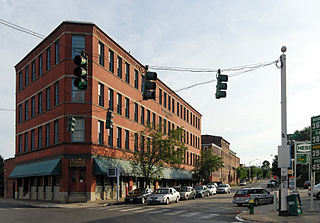
Davol Square is a historic area within the Jewelry District of Providence, Rhode Island. It is located at the intersection of Point Street and Eddy Street.

The American Brewing Company Plant, owned by the American Brewing Company, is a historic brewery complex at 431 Harris Avenue in Providence, Rhode Island that operated between 1892 and 1922. It is a well-preserved example of a state of the art late 19th century brewery building, its original functions still discernible in its layout. It was only used as a brewery until 1922, when it was shut down by Prohibition; it has served as a warehouse and storage facility for most of the time since. The complex was listed on the National Register of Historic Places in 2016.

The Jenckes Spinning Company is a historic textile factory complex in Pawtucket, Rhode Island. Located on Conant and Weeden Streets, the complex was developed between 1883 and 1919, and was home to the city's largest employer in the 1910s, producing cotton fabric and fabric for use in automotive tires until 1933. The factory complex was listed on the National Register of Historic Places in 2018.
























